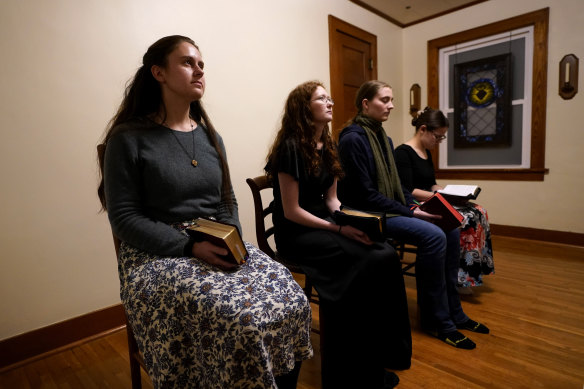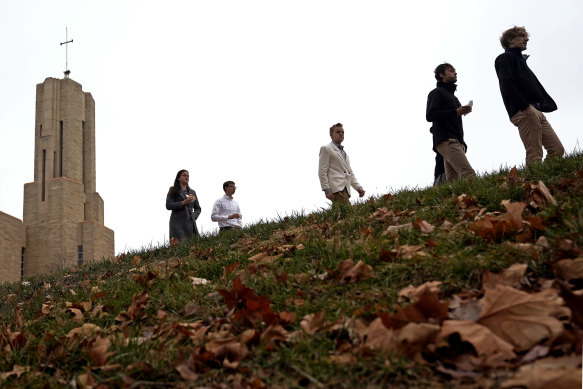
Loading
The changes are not happening everywhere. There are still plenty of liberal parishes, plenty that see themselves as middle-of-the-road. Despite their growing influence, conservative Catholics remain a minority.
Yet the changes they have brought are impossible to miss.
The progressive priests who dominated the US church in the years after Vatican II are now in their 70s and 80s. Many are retired. Some are dead. Younger priests, surveys show, are far more conservative.
At St Maria Goretti, once steeped in the ethos of Vatican II, many parishioners saw the changes as a requiem.
“I don’t want my daughter to be Catholic,” said Christine Hammond, whose family left the parish when the new outlook spilt into the church’s school and her daughter’s classroom. “Not if this is the Roman Catholic Church that is coming.”

Benedictine College students, from left, Madeline Hays, Niki Wood, Ashley Lestone and Hannah Moore gather for evening prayers in a room which they converted to a chapel in the house they share in Atchison, Kansas. Credit: AP
But this is not a simple story. Because there are many who welcome this new, old church.
They often stand out in the pews, with the men in ties and the women sometimes with the lace head coverings that all but disappeared from American churches more than 50 years ago. Large families signal adherence to the church’s contraception ban, which most Americans have casually ignored.
Many yearn for Masses that echo with medieval traditions – more Latin, more incense, more Gregorian chants.
Loading
“We want this ethereal experience that is different from everything else in our lives,” said Ben Rouleau, who until recently led St Maria Goretti’s young adult group, which saw membership skyrocket even as the parish shrank amid the turmoil.
If this movement emerged from anywhere, it might be a now-demolished Denver football stadium.
Some 500,000 people descended on Denver in 1993 for the Catholic festival World Youth Day.
Pope John Paul II, who was beloved both for his kindness and his sternness, confronted an American church shaped by decades of progressive change.
The church had grown increasingly liberal since Vatican II. Confession was rarely mentioned, Latin largely abandoned. Catholic social teaching on poverty suffused churches.

Students leave after attending a Catholic Mass at Benedictine College in Kansas.Credit: AP
On some issues, John Paul II agreed with liberal-minded Catholics, speaking against capital punishment and for workers’ rights. He preached relentlessly about forgiveness.
But he was uncompromising on dogma.
Catholics “are in danger of losing their faith,” he said in Denver, decrying abortion, drug abuse, and what he called “sexual disorders”.
Across the nation, fervent young Catholics listened.
Yet even today, surveys show most American Catholics are far from orthodox. Most support abortion rights. The vast majority use birth control.
But increasingly, those Catholics are not in church.
In 1970, more than half of America’s Catholics said they went to Mass at least once a week. By 2022, that had fallen to 17 per cent, according to CARA, a research centre affiliated with Georgetown University. Among millennials, it’s just 9 per cent.
As a result, those who remain in the church have outsized influence.
On the national level, conservatives increasingly dominate the US Catholic Bishops Conference and the Catholic intellectual world. They include everyone from the philanthropist founder of Domino’s Pizza to six of the nine US Supreme Court justices.
Then there’s the priesthood.
Young priests driven by liberal politics and progressive theology, so common in the 1960s and 70s, have all but vanished.
In churches from Minnesota to California, liberal parishioners have protested changes introduced by new conservative priests. Each can seem like one more skirmish in the cultural and political battles tearing at America.
Looming above the American divide is Pope Francis, who has pushed the global church to be inclusive, even as he stands firm on dogma.
The orthodox movement has watched him nervously, angered by his more liberal views on issues like gay relationships and divorce. Some reject him entirely.
And the pope worries about America.
The US church has “a very strong reactionary attitude,” he said last year.
St Maria Goretti is a well-kept island of Catholicism tucked into one of America’s most liberal cities.
In 2021, a new priest, the Reverend Scott Emerson, was named pastor.
Parishioners watched the changes - some pleased, some uneasily. Emerson’s sermons are not all fire-and-brimstone. He often speaks about forgiveness and compassion. But his tone shocked many longtime parishioners.
Protection is needed, he said in a 2023 service, from “the spiritual corruption of worldly vices.” He has warned against critics – “the atheists, journalists, politicians, the fallen-away Catholics” – he said were undermining the church.
But those critics, he says, will be proven wrong.
“How many have laughed at the church, announcing that she was passé, that her days were over and that they would bury her?” he said in a 2021 Mass.
“The church,” he said, “has buried every one of her undertakers.”



























